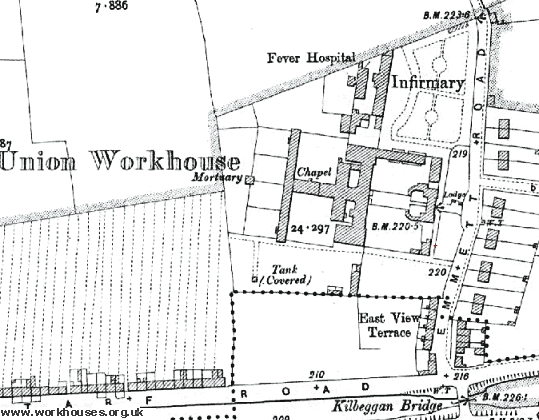Tullamore, Co. Offaly (King's County)
Tullamore Poor Law Union was formally declared on the 16th September 1839 and covered an area of 246 square miles. Its operation was overseen by an elected Board of Guardians, 24 in number, representing its 15 electoral divisions as listed below (figures in brackets indicate numbers of Guardians if more than one):
King's County: Ballycommon, Cappincor, Clara (2), Durrow, Geashill, Kilclonfert, Killeagh, Killoughy (2), Kilmonaghan, Philipstown (2), Rahan (2), Rathfeston, Tullamore (5).
Co. Westmeath: Kilbeggan (2), Rahugh.
The Board also included 8 ex-officio Guardians, making a total of 32. The Guardians met each week on Tuesday.
The population falling within the Union at the 1831 census had been 52,852 with divisions ranging in size from Kilclonfert (population 1,187) to Tullamore itself (11,519).
The new Tullamore Union workhouse was erected on a 6.5-acre site on Emmett Road at the north of Tullamore. Designed by the Poor Law Commissioners' architect George Wilkinson, the building was based on one of his standard plans to accommodate 700 inmates. Its construction cost £5,950 plus £1,265 for fittings etc. The workhouse was declared fit for the reception of paupers on 25th April 1842, and received its first admissions on 9th June. The workhouse location and layout are shown on the 1910 map below.

Tullamore workhouse site, 1910
The buildings followed Wilkinson's typical layout. An entrance and administrative block at the south-east of the site contained a porter's room and waiting room at the centre with the Guardians' board room on the first floor above.
The main accommodation block had the Master's quarters at the centre, with male and female wings to each side. At the rear, a range of single-storey utility rooms such as bakehouse and washhouse connected through to the infirmary and idiots' wards via a central spine containing the chapel and dining-hall.
During the famine in the mid-1840s, a 40-bed fever hospital was erected at the north of the workhouse, and a house hired for a further 50 patients. An additional infirmary block was later placed nearby.
In 1895, Tullamore was visited by a "commission" from the British Medical Journal investigating conditions in Irish workhouse infirmaries. Their report made a number of criticisms and recommendations. The Sisters of Mercy, employed as nurses at the workhouse, were praised for the quality of the care they provided. However, they lacked formal training and were overstretched so that pauper inmates were used to assist with the nursing. More dayrooms, and improved sanitary facilities were also avdoctaed. Further details are available in the full report.
In 1903, four nuns were being employed at the workhouse: three as nurses and one as a schoolmistress.
After the creation of the Irish Free State in 1922, Tullamore workhouse was redesignated as a County Home and accommodated the aged and infirm, chronic invalids, married mothers, unmarried mothers, infants and older children. Although not intended to house lunatics, some were reported still to be in residence in 1927. The workhouse infirmary was redeployed as Offaly's County Hospital.
The former workhouse buildings are understood to have been demolished in the 1970s.
Records
Note: many repositories impose a closure period of up to 100 years for records identifying individuals. Before travelling a long distance, always check that the records you want to consult will be available.
- Offaly Archives, Offaly Archives Unit 1F, Axis Business Park, Clara Road, Tullamore, Co Offaly.
Bibliography
- Crossman, V (2006) Politics, Pauperism and Power in Late Nineteenth-century Ireland
- Gray, P (2009) The Making of the Irish Poor Law, 1815-43
- O'Connor, J (1995) The Workhouses of Ireland
Links
- None.
Unless otherwise indicated, this page () is copyright Peter Higginbotham. Contents may not be reproduced without permission.


